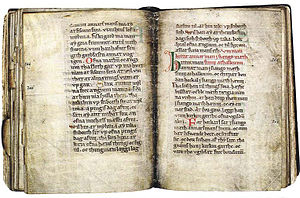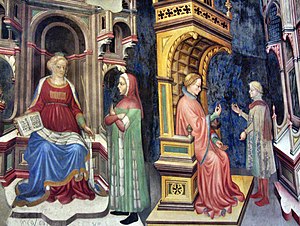Pe̍h-ōe
- "Pe̍h-ōe" ê kî-tha ì-sù, khòaⁿ pe̍h-ōe (khu-pia̍t-ia̍h).
Pe̍h-ōe (Eng-gí: vernacular language), ia̍h sī kóng hiong-tâm[1] (hiuⁿ-), ū-sî kóng hong-giân, sī kóng chi̍t-ê cho̍k-kûn ia̍h tē-hng ê chāi-lâi giân-gí he̍k-chiá sī khiuⁿ-kháu, iû-kî sī m̄-sī thoân-thóng-siōng siá-chok bûn-ha̍k ia̍h tòng chò kok-ka piau-chún-gí ê ōe.


Chá-kî ê pe̍h-ōe bûn-hoat
siu-kái1437 nî kàu 1586 nî kan, Au-chiu chhut-hiān Italia-gí, Se-pan-gâ-gí, Hoat-gí, Hô-lân-gí, Tek-gí kap Eng-gí ê bûn-hoat kì-lio̍k. Che sī chia pe̍h-ōe āu--lâi kúi pah tang kòe-têng piau-chún-hòa ê ki-chhó͘ chi it.
Chá-kî ê pe̍h-ōe sû-tián
siu-káiSû-tián (dictionary) kap gú-lūi-chi̍p (glossary) sī bô sio-siâng. Chong-sī chin-chē gú-lūi-chi̍p chin chá to̍h ū, pí-lūn Seville ê Isidore chhut ê Etymologiae, khai-lia̍t chin chē Se-pan-gâ-gí ê tan-jī.
Hô-lân-gí
siu-káiHô-lân-gí ê gú-lūi-chi̍p tī chha-put-to 1470 nî ê sî-chūn chhut-hiān, tè-bé tī 16 sè-kì hoat-tián chhut 2 pún Hô-lân-gí sû-tián:[2]
- Christophe Plantin: Thesaurus Theutonicae Linguae, 1573
- Cornelis Kiliaan: Dictionarium Teutonico-Latinum, 1574 (tī 1599 nî ê tē-3 pán piàn Etymologicum)
Chham-khó
siu-kái- ↑ Ogawa Naoyosi, pian. (1931–1932). "鄉談". 臺日大辭典 Tai-Nichi Dai Jiten [Tâi-Ji̍t Tōa Sû-tián]. OCLC 25747241.
- ↑ Brachin 1985, p. 15
Tsham-khó bûn-hiàn
siu-kái- Bex, Tony (1999). "Representations of English in twentieth-century Britain: Fowler, Gowers, Partridge". Chū Bex, Tony; Watts, Richard J. Standard English: the widening debate. New York: Routledge. pp. 89–112. 0-415-19162-9.
- Brachin, Pierre (1985). The Dutch language: a survey. Leiden: E.J. Brill.
- Champneys, Arthur Charles (1893). History of English: a sketch of the origin and development of the English with Examples, Down to the Present Day. New York: Macmillan and Co.
- DeGrauwe, Luc (2002). "Emerging Mother-Tongue Awareness: The Special Case of Dutch and German in the Middle Ages and the Early Modern Period". Chū Linn, Andrew Robert; McLelland, Nicola. Standardization: studies from the Germanic languages. Amsterdam; Philadelphis: John Benjamins Publishing Co. pp. 99–116.
- Diez, Friedrich (1863). Introduction to the grammar of the Romance languages. London, Edinburgh: Williams and Norgate.
- Dons, Ute (2004). Descriptive adequacy of early modern English grammars. Topics in English Linguistics. 47. Berlin; New York: Mouton de Gruyter.
- Fasold, Ralph W. (1984). The sociolinguistics of society. 1. Oxford, England; New York, NY, USA: B. Blackwell.
- Keller, Marcello Sorce (1984). "Folk Music in Trentino: Oral Transmission and the Use of Vernacular Languages". Ethnomusicology. XXVIII (1): 75–89. doi:10.2307/851432. JSTOR 851432.
- Lodge, R. Anthony (2005). A sociolinguistic history of Parisian French. Cambridge [u.a.]: Cambridge University Press.
- Mesthrie, Rajend (1999). Introducing sociolinguistics. Edinburgh: Edinburgh University Press.
- Noordegraaf, Jan (2000). "The Normative Study of the National Languages from the 17th Century Onwards". Chū Auroux, Sylvain. History of the language sciences: an international handbook on the evolution of the study of language from the beginnings to the present. Handbücher zur Sprach- und Kommunikationswissenschaft, Bd. 18. 2. Berlin; New York: Walter de Gruyter. pp. 893–900.
- Wells, C. J. (1985). German, a linguistic history to 1945. Oxford, New York: Oxford University Press.
- Suhardi, B.; Sembiring, B. Cornelius (2007). "Aspek sosial bahasa". Chū Kushartanti; Yuwono, Untung; Lauder, Multamia R. M. T. Pesona bahasa: langkah awal memahami linguistik (ēng Ìn-nî-gí). Jakarta: Gramedia Pustaka Utama. ISBN 978-9792216813. OCLC 156874430.
- Fodde Melis, Luisanna (2002). Race, Ethnicity and Dialects: Language Policy and Ethnic Minorities in the United States. FrancoAngeli. ISBN 9788846439123.
Siong-koan
siu-káiGuā-pōo liân-kiat
siu-kái- Illich. "Vernacular Values". The Preservation Institute. goân-loē-iông tī 20 July 2016 hőng khó͘-pih. 7 November 2009 khòaⁿ--ê.
| Pún bûn-chiuⁿ sī chi̍t phiⁿ phí-á-kiáⁿ. Lí thang tàu khok-chhiong lâi pang-chō͘ Wikipedia. |